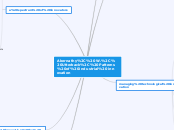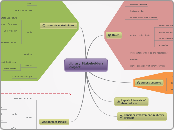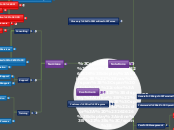Abernathy, W., Utterback, Patterns of industrial innovation
consistency of management action
common explanation of failure
conditions necessary to support sought after technical advance unpresent
is government policy to maintain diversified markets consistent with high product innovation effectivity?
can governments stimulate productivity by forcing young industries to standardize products before dominant designes are realized?
would actions to restructure work environment make taks less repetitive be compatible with policies of mechanization to reduce labor needs?
is product innovation consistent with an effort to substantially reduce costs through backward integration?
can a firm increase variety and diversity of products while realizing highest efficiency?
fostering innovation by understanding transition
units in different stages respond to differing stimuli, undertake different types of innovation
barriers of innovation
unmet conditions for transition
barriers may make transition impossible
sometimes so fast that it's unrecognized
established units: government regulation & vulnerability of existing investments
new units: product standardization & market aggregation
transition from product to mass production and product to process innovation
a spectrum of innovators
new products
organisations should be
economies of scale not of prime importance because of rapid product change
good external communications
flexible
adaptable
small
users important in suggesting needs & ultimate form
performance criteria vague
higher unit profit margins
competitive advantage = superior performance
occure more in
scienc-based universities/ research institutions
entrepreneurially oriented financial institutions
affluent markets
identification of emerging needs or new ways to meet existing needs
often require reorientation of corporate goals or productoin facilities
high volume products
productive unit loses flexibility
increasingly vulnerable to changed demand
change becomes costly because of high integration
concurrention based on efficiency and price
unit profit low
product characteristics are well understood and standardized
well defined markets
innovation is incremental by nature
economies of scale
performance advances
cost reduction major incentive
often more than half of the total ultimate economic gain
due to greater number
countless minor product and system improvements
managing technological innovation
dominant design displayede by following qualities
assure expansion into new markets
enhance value of potential innovations in other elements of a product or process
lift technical constraints without creating new ones
regugaltory constraints= new performance dimensions
early stages
--> users often innovators
relative importance criteria unclear
performance criteria not quantificable
performance criteria cannot be stated quantitatively
relat
from ill-defined and uncertain targets to well-articulated design objectives
beginning: often purchased equipment, when fully matured --> processes likely to be designed as integrated systems + innovation outside the unit
formal R&D investments when uncertainty and targets become more clear
uncertainty
capacity to process information
later on: reducing need for information processing
later on: formal planning groups etc.
little incentive for major investments in formal R&D
relevant technologies little explored
a transition from radical to evolutionary innovation
processed food: innovation came from individuals and small organizations
research relied on information from users
challange for radical innovations: gaining experience to select dominant design
from flexible, manual labour and general purpose equipment to automated, equipment intensive and high-volume processes
increased emphasis on process innovation
accompanied by heightening price competition
organizations with incremental innovations were often first small fluid units with focus on product innovation
not rigid, independent categories
radical innovation --> incremental change
unit of analysis
productive unit = 1 operating manager
several separate firms
diversified firm
simple firm/ single product
product change:
government sponsorship of change
invasion from leading firms in other industries
from start-ups
introduced outside established industry
productive unit's capacity and methods of innovation vary on:
major high-volume producer
small technology based enterprise









